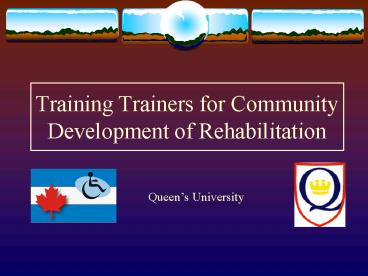Training Trainers for Community Development of Rehabilitation PowerPoint PPT Presentation
1 / 24
Title: Training Trainers for Community Development of Rehabilitation
1
Training Trainers for Community Development of
Rehabilitation
- Queens University
2
Central America Land Mine Survivors Project
- Will Boyce
- Director
- Gustavo Vargas
- International Project Manager
3
Tripartite Land Mine Initiative
- Canada, Mexico and 3 Central American countries
of Nicaragua, El Salvador and Honduras with the
technical assistance of PAHO. - Four persistent problems for persons with
disabilities - Lack of services in rural areas
- Prosthesis supply and costs
- Social and economic reintegration
- Lack of rehabilitation information
4
Central America Region
5
GOALS
- increase public awareness of the continuing
dangers of landmines - establish CBR programs
- sensitize the public about human rights issues of
disability - train multi-disciplinary team approach in
rehabilitation
6
Project Components
- Prosthetics Orthotics
- Economic Re-Integration
- Health and Disability Information Systems
- Community Based Rehabilitation
7
Community Based Rehabilitation
- Basic education on CBR
- National planning consultations
- Production of CBR resource material
- Train the trainers program and manuals
- University curriculum development
- Monitoring and follow-up support
8
Train the Trainers - Goal
- To create a nucleus of well trained and skilled
people available to teach CBR within their own
country
9
Train the Trainers Rationale
- Better use of resources
- Sustainable
- Adaptable to each country
- Shared responsibility with local partners
10
Training Model
- Basic Education Workshops
- Awareness of Disability
- Community-based Rehabilitation
- Clinical Skills in Communities Settings
11
Training of Trainers
- 3 Training modules over 6 months
- Basic Training in Adult Education and CBR
- develop own workshop topic and outline
- Advanced Training in Workshop Planning and CBR
Management - conduct workshop, with feedback
- Establishing and Evaluating Local Training
Courses
12
Challenges in T.O.T
- Coordination
- Lack of resource material
- Sustainability
- Administrative support
- Certification
- Local trainers
- Community Involvement
- Integration of agencies other than health
13
Research on T.O.T-PTs training CBR workers
- Benefits
- Consolidation of learning
- Use of existing networks
- Meets community needs
- Modifies information
- Capacity building
- Problems
- Available time for training
- Slower implementation
- Loss of detail
- Evaluation problems
- Lower skill transfer
14
Educators Manuals for CBR Community
Development and Integration of PWD
- 1. Key Concepts
- 2. Training Trainers in CBR
- Education
- Workshop Planning
- 3. Disability
- Understandings of Disability
- Working with People with Disabilities
- 4. Community Development Strategies in Disability
- Needs Resources Assessment
- Link between Needs and Resources
- Access to Information
- Inclusion of PWD and Community Participation
- Community Networks Partnerships
15
A Educators Manual (contd)
- 5. Rehabilitation in the Community
- Roles in CBR
- Responsibility of CBR Workers
- Responsibility of the Community
- Responsibility of the CBR Organization
(Management)
- 6. Problem Solving in Rehabilitation
- Functional Life Activities
- Appropriate Technology
- (Worksheets, Learning Exercises Tips to the
Trainer, Handouts are included throughout the
manual to maximize comprehension and integration
of each topic).
16
Prosthetics Orthotics
- Feasibility study in Honduras
- Technician workshops
- Interagency cooperation (GTZ)
- Introduction of New Technologies (UDB)
17
Low Cost Modular Prosthetic System
The Niagara Foot
18
Shortcomings of Current Devices
- High cost
- most common foot in developing countries is
the SACH foot which sells for about 50 US - Susceptibility to damage by water
- SACH foot is made primarily of wood and rubber
19
Shortcomings of Current Devices
- Long fabrication time
- example Jaipur foot
- Poor performance on rough ground walking due to
lack of motion of the foot - example the recently developed Japanese foot
20
Design Considerations
- For developing countries
- Cultural differences
- closed shoes vs. barefoot or
- open footwear
- chair sitting vs. floor sitting
- removal of footwear when
- indoors
- Biomechanical differences
- squatting
- absorption of ground reaction forces vs. energy
release
21
Design Objectives
- Low Cost
- projected at 7 US
- Simple Design
- one piece
- easy to fit and repair
- few breakable parts
- Durable
- increased life expectancy of foot
22
Cyclic Testing
23
Cambodia - Thailand Field Trials
24
Initial Results
- Flexibility desired
- Need stiffer foot for carrying heavy loads
- Fit to a shoe

